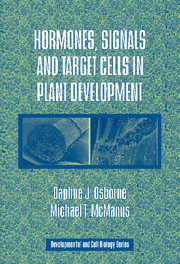Book contents
- Frontmatter
- Contents
- Preface
- 1 Introduction
- 2 Hormones and Signals: Identification and Description of Signalling Molecules
- 3 Cell-to-Cell Signalling: Short and Long Distance
- 4 Population Diversity of Cell Types and Target Identification in Higher Plants
- 5 Flexibility of Cell Types and the Target Cell Status
- 6 Terminally Committed Cell Types and the Target Status
- 7 The Mechanisms of Target Cell Perception and Response to Specific Signals
- 8 Hormone Action and the Relief of Repression
- 9 The Phenomenon of Hormonal Cross-Talk
- References
- Index
8 - Hormone Action and the Relief of Repression
Published online by Cambridge University Press: 06 August 2009
- Frontmatter
- Contents
- Preface
- 1 Introduction
- 2 Hormones and Signals: Identification and Description of Signalling Molecules
- 3 Cell-to-Cell Signalling: Short and Long Distance
- 4 Population Diversity of Cell Types and Target Identification in Higher Plants
- 5 Flexibility of Cell Types and the Target Cell Status
- 6 Terminally Committed Cell Types and the Target Status
- 7 The Mechanisms of Target Cell Perception and Response to Specific Signals
- 8 Hormone Action and the Relief of Repression
- 9 The Phenomenon of Hormonal Cross-Talk
- References
- Index
Summary
In the previous chapter, we considered the perception of auxin and ethylene in different target tissues. While these hormones were treated separately, the essential mode of action of ethylene and auxin is to relieve a pre-existing repression of response (see Figures 7.2 and 7.4). It is now clear that this mode of action of hormonal signals is widespread amongst plants. In this chapter we look at three further examples, the cytokinins, gibberellins and brassinosteroids, and again examine the evidence for perception of these signals via binding proteins or receptors in different target cells. We additionally examine the evidence that these developmental cues operate through the relief of pre-existing repressions of molecular responses in each cell type examined.
Cytokinin perception in the context of receptors and target cells
Two spectacular events in plant development are attributable to the action of cytokinins. The first, is the conversion of the cells of a callus culture into the organisational complexities of a shoot meristem. Cytokinins act not alone, but in concert with auxin, the ratio of one to the other being critical for optimal organ development. The second is the maintenance of the non-senescent state in specific tissues. Here, cytokinins act as repressors of cell death programmes in many target cell types, most notably those of the leafy tissues of herbaceous plants. Seemingly, there is a requirement for cytokinins primarily synthesised in the root meristems for the retention of metabolic function in the green shoot.
- Type
- Chapter
- Information
- Hormones, Signals and Target Cells in Plant Development , pp. 179 - 197Publisher: Cambridge University PressPrint publication year: 2005



